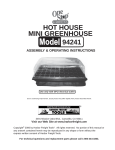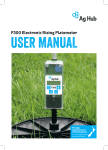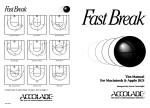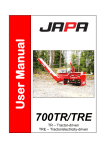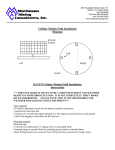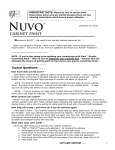Download The Slammer User Manual
Transcript
The Slammer.co.nz the kiwi supertool www.cerebrallc.com Operating Manual Good on ya! You have just purchased one of the most useful and versatile tools on the planet. The slide-hammer concept has been around for ages, but the design and materials used for the Slammer has been a 23-year evolution of countless prototypes to make it as sturdy and robust as the one you now own. It gives the user the mechanical advantage of a lot of force to a small area, focusing the energy to where you want it, over and over again. I used to carry a crowbar (digging bar), mattock/grubber, axe and spade in my work truck. When dealing with hard ground, roots, rocks, concrete and well-compacted soil types (clay, sedimentary, conglomerates) these tools are standard. However, once I started using the Slammer I found not only did it take less time to complete a task; it used a completely different set of muscles that did not hurt my back. The key to this was to grip the bar with my hands, but use my legs to get my body to move the bar up and down, rather than my arms. The other big feature was once the tool was driven into an ugly patch, to get it out was a lot of work. So that is how the head of the tool ended up looking the way it does, you rock the tool from side to side to “walk its way out”. If you work smart, you can work more productively. 2 I didn’t initially make the Slammer to sell commercially. I just wanted a simple, indestructible, multi-use tool for myself for tough, labour-intensive jobs. Clients, friends and co-workers saw my Slammer and asked if I could make one for them. Then things just escalated through word of mouth and The Slammer Ltd was born. I filed a PCT patent 583181, took the Slammer to a large Agricultural Show in NZ (Fieldays) and started to fill orders from a very diverse group of people. This manual is to show you a few tips and uses that I have learned along the Slammer journey. Other techniques have been shown to me by customers who have provided comments and feedback. Please get in touch to let us know what you think of the Slammer and what you use it for. HAPPY SLAMMIN! T.J “Slammerman” Irvin. 3 Do Operator instructions MALE (UPPER SECTION) The Slammer has 2 pieces. The upper section (or male part) and the lower section (or female part). USE EAR PROTECTION. The Slammer produces a loud repetitive noise. USE EYE PROTECTION. Objects may become airborne when using The Slammer. FEMALE (LOWER SECTION) Wear protective footwear and gloves. handle blade 4 When operating the Slammer take care not to trap your fingers or hands in between the two parts. Both hands should grip the upper section. Use your leg or core muscles to raise and lower the slide bar, as opposed to just your upper body strength. Be aware of objects and cables underground. Always know before you start digging. DoN’T USE YOUR BACK. Use gravity and the natural weight of The Slammer to ‘Slam’ it down, then walk The Slammer out without using your back. Tip: When walking with the slammer, hold it in 2 separate pieces – one in each hand. 5 Digging Use the Slammer like you would a crow bar to break up the soil. Use a spade to remove the broken soil. Tip: dig from your knees and try not to use your back like a crane. If digging in sod, cut around the area you are digging, chop in two then cut under to get perfect bits of sod just using the bottom or female part of the Slammer (which I often use without the bar). When digging fence posts use the Slammer to break up soil then lift soil with weapon of choice. (Hand auger, post hole digger, post hole spade. You can use female part of the Slammer but slow.) 6 When digging, deep slam from your knees. A helpful hint is to mark different depths on the female part of the tool to know when you are deep enough or where to expect service (sewer, power, phone). Tamp with the male part of slammer at the bottom of hole, then attach rammer to tamp the rest of hole tight. rammer “The only time in life you start out on top is when you are digging a hole.” – anonymous. 7 Planting Trees and plants The bigger the hole the faster the tree/plant will grow. Use the Slammer to aerate the soil deep and wide. Remove all existing plants, roots and rocks and loosen the soil. It’s not necessary to lift all the dirt out of the hole. Mix in compost, fertilizer or blood and bone. (Or you could use “ferralizer” – road-kill such as a dead possum or rabbit.) Once planted, pack well and stake if necessary. Add water to fill in gaps. 8 9 Transplanting Make sure the blade on the Slammer is sharp. Use the Slammer to cut around the root ball. Find main roots and slam through. Continue to slam on an angle to form root ball. Lift with slammer around the root ball, place into fabric, pot, tarp or whatever will keep the root ball from breaking up. Cuttings of flax, bamboo or large grasses • Tie or cut back plant to gain access to main base of plant. Cut into root base, rock blade from side to side to walk out. • Pry roots apart. Cut root ball around desired cutting and keep root ball together. Try to keep damp and replant as soon as possible. This cutting may need some pruning above soil to minimize shock. In dense bamboo roots you may have to cut multiple times when prying out. If Slammer bends whenprying, next pry try to bend the opposite way to straighten tool out again. E • With extended bamboo work it is advisable to use two people with a slammer each to work and lift together. 10 11 Splitting Firewood As the Slammer blade is narrow it works best on hard wood. It can get jammed on soft wood. Choose straight grain pieces for splitting and kindling. Save the knotty bits for the wood splitter or as long burning, all night logs. Instead of putting wood on a block, put wood on a hard surface with a piece of plywood underneath, then step up so that the Slammer blade is level with your feet. Split from the outside using the blade with the grain for large rounds and in half for small rounds. The Slammer can be used to gain leverage when sawing logs so that rounds fall away from logs. It is also helpful for turning big logs over and un-jamming stuck saw-blades. “Ye who works to get the wood gets warm twice.” Tip: Get an old tyre, put around wood so as the wood splits, it stays standing to be split again. 12 13 Breaking up Concrete The blade will take more effort than a point but once the blade is in the crack the blade is quicker to use. Once cracked, follow crack and break up bits that you can carry. Works extremely well on asphalt to square up potholes for road repairs. The Slammer is very good working with a concrete cutter to remove concrete accurately. Tip: The Slammer tool is great for putting in pilot holes for wooden pegs for boxing (and for getting them out without breaking them) and also for removing the boxing. The Rammer attachment with foot is great for tamping/compressing areas in corners and tight spaces where you cannot get a vibrator/compressor. 14 “Nothing is forever” 15 Removing stumps & woody weeds Mandraulic Power With the Slammer’s sharp blade, cut around the stump and locate areas with large roots. Large roots may have to be cut further from stump. Cut underneath root and break off completely. Work back to main stump to loosen soil in area. Continue to cut and pry until the stump moves. Once stump is moving, remove material and cut taproot at bottom, then pry out of hole. When dealing with woody weeds with long taproots, sometimes the female part of the Slammer is enough to dig down and lift the root out of the ground. Tip: For best results do this before plants seed! If not, use the Slammer to drive down taproot, loosen then pull. 16 As with removing bamboo – one Slammer is great, two Slammers are fantastic! Tip: for large roots cut at 45° one way then 45° opposite until you get though like an axe. 17 Removing tiles, adhesives, ice & hard-remove surface coatings The Slammer blade works well, but a straight blade with a 45° angle works much better. The rammer attachment with a 5mm flat piece of steel 6cm x 15cm blade at a 45° angle works well to remove both tile and adhesive without scarring concrete. Tip: this also works well for ice, dried mud, effluent, linoleum and other hard to remove surface coatings. Custom tile-removing tools can be made to order. 18 Contact details at www.theslammer.co.nz www.cerebrallc.com 19 Tip: Weigh down cable so if Anchor point/deadman for winching vehicles, boats and heavy loads it breaks it will not go through vehicle’s windscreen. Your Slammer is very strong, but only as strong as the ground that it is driven into. Remove by rocking Slammer side to side with blade to work out of hole. If stuck lift the male part of Slammer out to gain more leverage. The blade must be perpendicular to the load being pulled. Angle the Slammer away from load and drive deep for hard soils. For soft soils (mud, sand, loam and the like) a plate must be used. We recommend a plate 50cm x 50cm square, 5mm thick with a 10cm x 20cm rectangular hole in the middle to shackle though. (This plate can also double up for cooking on over an open fire.) With the plate you are displacing the weight with surface area. The Slammer is used to dig out the area that the plate will be placed. Tip: a spade will be more useful for soft soils. Then the Slammer is slammed in behind the plate so that the shackle/winch rope is attached to the Slammer. 20 21 Basic maintenance of your Slammer • Brush dirt off the Slammer after use and wipe down with a penetrating oil. The outside may show rust spots, but the metal will not structurally rust. • There is a woollen plug at the base of the female section of the Slammer. This is to reduce noise and shock. If the male part of the Slammer ever gets stuck in the female part, the plug may have become worn, damp or dislodged. Secure the blade, then twist and pull the male part out. Remove old wool by using some number 8 wire to twist and hook out. You can also flip female part upsidedown. Hit blade/ pipe connection and debris will fall out. • Replacing the woollen plug. The wool used is from a good old woollen Kiwi blanket. Cut a 3cm x 25 cm strip then roll up and place into the female part of the tool. Use male part to gently push plug to bottom of female part with male part. • Lightly grease the male shaft and wipe off excess. • When sharpening the blade, use a grinder with a grinding disk (not a cut off disk.) Hand files are good for removing burrs. Angles depend on use. Standard rule – hard concrete, rock or stone use a broad angle. For cutting roots, bone, wood use a sharp angle. The Slammer has a sharp angle when first purchased. • Over time, with lots of use, the bottom tip of the male part of the Slammer may “mushroom” slightly and could start to jam. To prevent this, grind the tip down. • When using the Slammer as a pry bar the female part may bend and this may cause the male part to jam. It will have to be bent back in the opposite direction to straighten out. (Try prying in opposite direction with a heavy object.) Or take the tool to a local engineer to straighten with a large heavy press. The Slammer.co.nz the kiwi supertool www.cerebrallc.com 22 23 For more helpful tips, videos and user comments you can visit our website or follow us on Facebook “The Slammer tool” The Slammer.co.nz the kiwi supertool www.theslammer.co.nz www.cerebrallc.com email [email protected]















